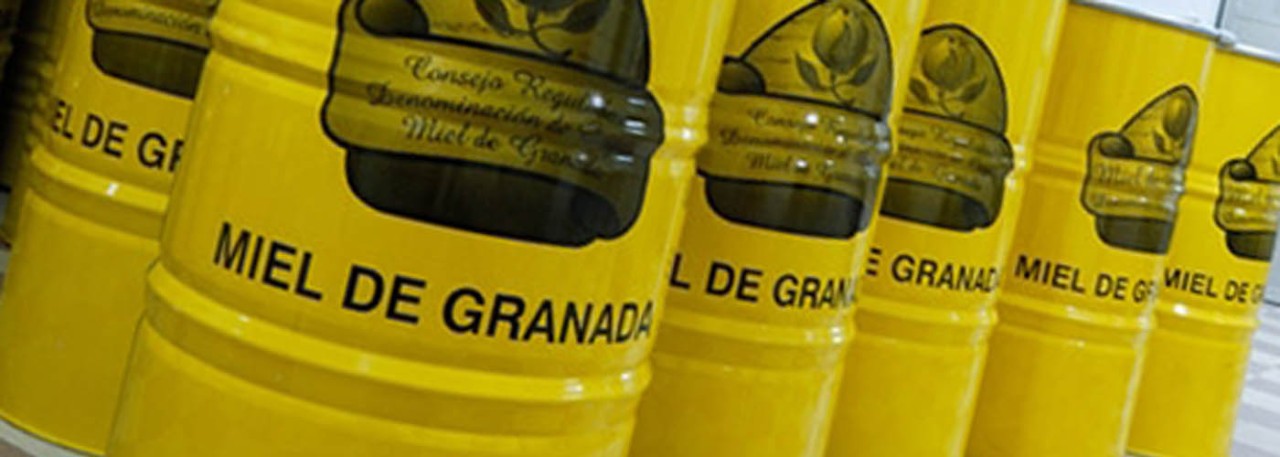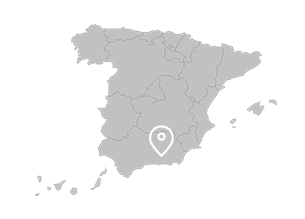.png.transform/rendition-xs/image_image%20(1).png)
Miel de Granada PDO
Honey made by the honey bee from the nectar of flowers or from secretions coming from the living parts of plants or found on them which the bees suck, transform, combine with specific substances, store and leave to ripen in the honeycomb inside the hives located within the designated area.
Tasting notes
- Chestnut honey: strong, penetrating aroma, characteristic flavor of ripe apples, bitter, astringent aftertaste because of the tannin content, and a dark color with attractive greenish-red reflections.
- Rosemary honey: delicate-flavored, very sweet, balsamic and with medium-high persistence, excellent aroma and light color, light yellow when liquid and whitish when solid.
- Thyme honey: intense aroma and flavor, with a dark amber color.
- Avocado honey: sweet, nutty flavor and dark brown color, almost black.
- Orange blossom honey: mild, penetrating, floral aroma, with a persistent, sharp, aromatic flavor, and light color with warm yellow tones.
- Spanish lavender honey: intense aroma and flavor, strong and penetrating, straw-to-amber color.
- Thousand-flower and Mountain honey: when harvested in spring, the color is light amber, but it darkens towards late spring and summer.
Other notes
General physical and chemical properties:
-Moisture content: below 17.5%
-Hydroxymethylfurfural: below 10 mg/kg
Specific physical and chemical properties:
-Chestnut honey: Glucosidase over 100. Conductivity above 8. Color above 80
-Rosemary honey: Glucosidase above 100. Conductivity below 2.5. Color below 35
- Thyme honey: Glucosidase above 100. Conductivity above 3. Color above 55
- Avocado honey: Glucosidase above 100. Conductivity above 8. Color above 100
- Orange blossom honey: Glucosidase above 100. Conductivity above 8. Color above 100
- Spanish lavender honey: Glucosidase above 50. Conductivity below 5. Color below 50
Note: Units of alpha-glucosidase are expressed in US, conductivity in 10-4 S/cm, and color according to the Pfund scale
General melisso-palynological characteristics:
-Pollen spectrum mostly Cistaceae, Lamiaceae, Fagaceae, Rosaceae, Asateraceae, Brassicaceae, Fabaceae, Myrtaceae, Borraginaceae, Salicaceae, Campanulaceae, Resedaceae, Plantaginaceae, Apiaceae, Caesalpinaceae and Lauraceae
-Erica sp.: below 1%
Specific melisso-palynological characteristics:
-Chestnut honey: over 75% Castanea sativa and no Erica sp.
-Rosemary honey: over 15% Rosmarinus officinalis, or 10% with over 5% Lamiaceae family
-Thyme honey: over 15% Thymus sp.
-Avocado honey: over 25% Persea americana
-Orange blossom honey: over 15% Citrus sp.
-Spanish lavender honey: over 15% Lavandula stoechas
-Thousand-flower honey: over 5% Lamiaceae family
-Mountain honey: over 20% Castanea sativa
Production / Processing method
The honey is extracted only from movable-frame hives, both vertical and horizontal, and from colonies having at least 25 registered production units. Colonies may not include production units that have not been entered in the PDO Producer Register. All the registered hives bear a registration plaque.
The honeycombs in the brood chamber frames must be no more than three years old. In vertical hives, the combs may be up to five years old. For testing, bees should be removed using the traditional system of brushes with one or two rows of natural bristles, or using a blower, minimizing the use of smoke. Bee repellents may not be used, whether in liquid, solid or gas form. The combs removed must be capped and must not contain brood. Uncapping is traditionally carried out using knives that have first been warmed in near-boiling water and removes the caps that are placed by the bees to close the honeycomb cells once the honey is ripe. The honey is always extracted from the honeycombs by spinning.
After extraction, the honey is stored in tubs made of food-grade plastic or metal coated with food-grade varnish.
When packed, in liquid (fluid) or solid (crystallized) form, there should be no defects such as separation of the phases, fermentation or marbling. The honey may also be presented in portions of completely capped, brood-free honeycomb.
If the honey has crystallized it may be liquefied for the purpose of decantation and packing but without exceeding 45ºC. This process must be carried out using the methods and equipment authorized by the Regulatory Council. Pasteurization of the honey is prohibited.
The honey is sold to the consumer in transparent, uncolored glass jars containing 500 g or 1,000 g. The shape should allow perfect decantation of any micro-bubbles forming during filling. The jars must be air-tight, in order to preserve the natural aromas and protect the honey from smells, ambient moisture, etc. which might affect its quality. The label and the PDO back label must allow the contents to be easily visible. Traditional ceramic pots are also allowed, providing the net weight is 500 g or 1,000 g and they are sealed tight to protect the natural aromas and to exclude new smells.
Geography / Relief and climate
The province of Granada is very varied in its relief and climate. The different altitudes and flowering types and times allow apiarists to develop north-south routes within the province, extracting honey all year round.
The bee-keepers along the coast, in the Lecrín valley and the Alpujarra-Sierra Nevada mountains set up vertical routes from the coast to the mountains and back, searching for vegetation coming into flower at different heights.
The main factor behind the special characteristics of the honey from Granada is the local flora in a province covering over 296,000 ha (731,416 acres) of scrubland growing aromatic plants as well as large areas of chestnuts and orange trees and, along the coast, avocados, which are grown exclusively in Spain along the Granada and Málaga coasts.
Almost 70% of the Granada apiaries are located in protected areas: Parque Nacional de Sierra Nevada, Parque Natural de Sierra Nevada, Parque Natural de la Sierra de Baza, Parque Natural de la Sierra de Huétor, Parque Natural de la Sierra de Castril and Parque Natural de las Sierras de Tejeda, Alhama y Almijara. These are isolated areas which offer a wealth of flora. Sierra Nevada alone is home to over 160 endemic plants.
Pollen studies in the province of Granada have identified about 92 forms belonging to about 50 botanical families. The honey from Granada is characterized by a spectrum comprising the Cistaceae, Lamiaceae, Fagaceae, Rosaceae, Asteraceae, Brassicaceae, Fabaceae, Borraginaceae, Salicaceae, Campanulaceae, Resedaceae, Plantaginaceae, Apiaceae, Caesalpinaceae amd Lauraceae families.
The chestnut and mountain honey is mainly harvested in the Sierra Nevada and the Alpujarra mountains. The Spanish lavender honey comes from mountains such as the Huétor and La Contraviesa sierras. Avocado honey comes from the valleys where avocados are cultivated in some parts of the Lower Alpujarras and especially in the Lecrín Valley. Rosemary and thyme honey are harvested throughout the province of Granada.
Regulatory Council
Consejo Regulador de la DOP Miel de Granada
C/ Barrancos, s/n - Finca Berta Wilhelmi
18420 Lanjarón (Granada)
Tel: (+34) 958 771 196
Fax: (+34) 958 771 196
mieldegranada@mieldegranada.com
www.mieldegranada.com
Sources:
- Spanish Ministry of Agriculture
Pollen studies in the province of Granada have identified about 92 forms belonging to about 50 botanical families.


- Miel de Granada 1
- Miel de Granada 2

Lanjarón (Andalusia)
